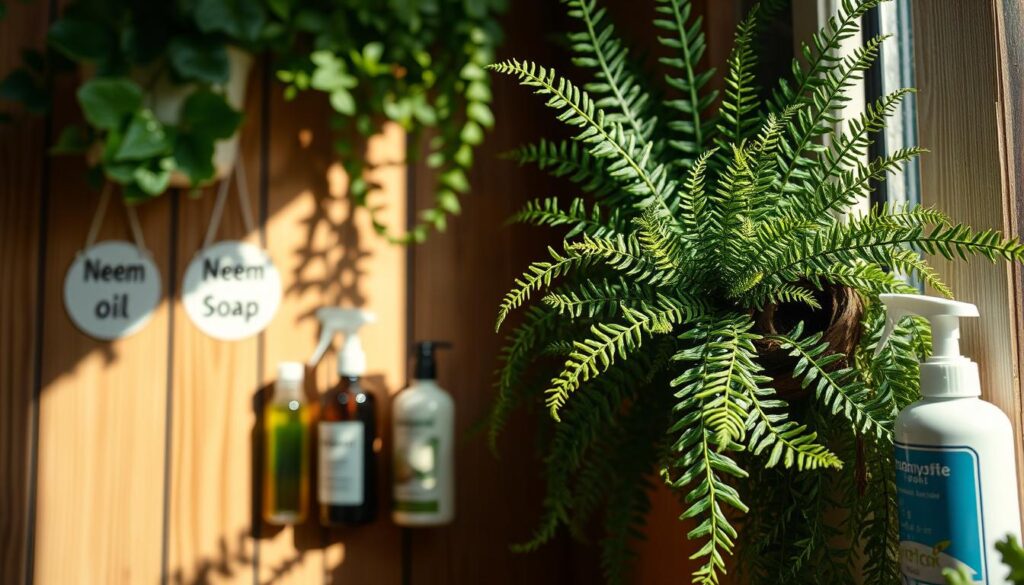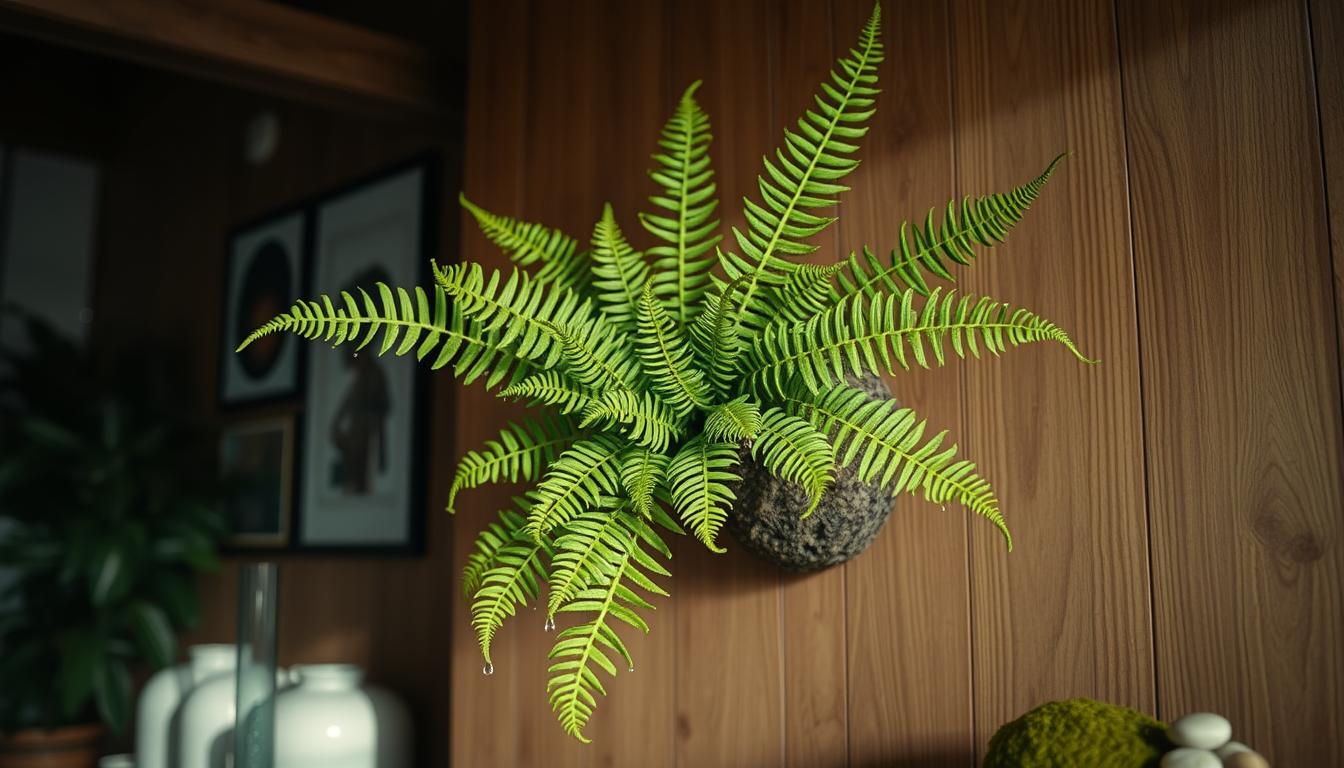To grow a Staghorn Fern, you need to know its special needs. This is key for Staghorn Fern plant care. You’ll learn how to give it the right light and humidity to grow well.
Staghorn Ferns are special plants that get water and food from their leaves. They like to hang on boards or in baskets. With over 12,000 fern species, they’re very old and beautiful.
By following the right care tips, you can enjoy a Staghorn Fern’s air-purifying and beautiful looks. You’ll learn how to keep it healthy and growing strong.
Introduction to Staghorn Ferns
Staghorn Ferns are unique plants with leaves that look like deer antlers. They can be hung on wood, adding greenery to your space. Knowing how to care for them is key, and we’ll share tips here.
Staghorn Ferns grow on other surfaces without harming them. They love humid places, making them great for rooms with lots of moisture. With the right care, your Staghorn Fern will thrive.
What Are Staghorn Ferns?
Staghorn Ferns are part of the Platycerium genus, with about 18 species. P. bifurcatum is the most common, growing up to 3 feet wide. Knowing about different types helps you care for them better.
Fascinating Features of Staghorn Ferns
Staghorn Ferns have shield fronds that protect their roots and help them grow. These fronds can be up to 18 inches long. Understanding these features helps you care for your Staghorn Fern.
With the right care, Staghorn Ferns can make your home beautiful. Learning about their unique traits and following care tips will help you enjoy having one.
Ideal Growing Conditions for Staghorn Ferns
To grow a healthy Staghorn Fern, you need to mimic its natural home. It likes bright, indirect light. But, it must avoid direct sun to keep its leaves safe.
Choosing the right soil is key. Use a mix made for epiphytes to stop root rot. For tips on caring for your Staghorn Fern, check out trusted houseplant guides.
Preferred Light Levels
Staghorn Ferns love partial sunlight. They do well in rooms with east- or west-facing windows. But, direct sunlight can harm their leaves.
Temperature and Humidity Requirements
These plants like temperatures between 50°F and 100°F. They also need humidity above 50%. To boost humidity, put the fern on a tray with water and pebbles or use a humidifier.
Choosing the Right Mounting Option
There are many ways to mount a Staghorn Fern. The best method can greatly affect your plant’s health and look. Staghorn Fern care tips stress the need for good mounting to avoid water problems.
Popular choices include wooden boards, tree trunks, or mixes like sphagnum moss and wire. The right choice depends on your fern’s size and type, and what you like. For example, using a mix that drains well can keep the right amount of moisture.
Here are some things to think about when picking a mounting option:
- Material: Look for rot-resistant woods like redwood, cedar, or cypress.
- Size: Choose a mounting board or tree trunk that is proportional to the size of your plant.
- Method: Consider using sphagnum moss and plant wire to secure your fern to the mounting surface.
By following these Staghorn Fern care tips and choosing the right mounting option, you can help your plant thrive. And you’ll get to enjoy its unique, epiphytic beauty.
Watering Techniques for Staghorn Ferns
To keep your Staghorn Fern healthy, you need to know how to water it right. This plant gets water from the air, but in places without much humidity, you might need to water it. A good Staghorn Fern watering guide will tell you when and how to do it.
Watering is key when caring for your Staghorn Fern. Water it when the fronds start to wilt a bit. Water it every 7-10 days, and less in winter.
Signs of Overwatering or Underwatering
Knowing the signs of too much or too little water is important. Too much water can cause black spots, while too little makes fronds dry and brittle. By following a Staghorn Fern watering guide, you can keep your plant just right.
Best Practices for Watering
Some good ways to water your Staghorn Fern include misting its fronds weekly. Let the soil dry a bit before watering again. For outdoor plants, use a gentle misting hose. These tips, along with a Staghorn Fern watering guide, will help your plant grow well.
Fertilizing Your Staghorn Fern
To keep your Staghorn Fern healthy, fertilizing is key. Fertilize it monthly in spring and summer. Use a balanced, water-soluble fertilizer for best growth.
Fertilizing is important for Staghorn Fern growth. It helps your fern grow well, making it easier to create new plants. Also, a healthy fern fights off pests and diseases better.
Best Fertilizers to Use
For your Staghorn Fern, use fertilizers like 10:10:10. Organic options like fish emulsion or coffee grounds are good too. Banana peels are also great, but they have less nitrogen.
Frequency of Fertilization
Fertilize your fern monthly when it’s growing fast. Young ferns need it every other month in cool seasons. Older ferns might only need one or two times a year. Follow these tips to keep your fern healthy and prevent pests.
Pests and Problems
When you care for your Staghorn Fern, watch out for pests and problems. Staghorn Fern pests control is key to keep your plant healthy. Check your plant often to catch issues early.
Aphids, mealybugs, and spider mites can harm your Staghorn Fern. These pests can make fronds turn color and fall off early. Give your fern good care like enough water, humidity, and food. Also, bright, indirect light and a steady temperature help prevent pests.
Here are some tips for Staghorn Fern pests control:
- Inspect your plant regularly for signs of pests or disease
- Use neem oil or insecticidal soap to treat infestations
- Provide proper care, including adequate watering, humidity, and fertilization
- Isolate infected plants to prevent the spread of pests or disease

Follow these Staghorn Fern care tips and watch for pests and problems. This way, your plant will stay healthy and strong. Always check your plant and act fast if you see any problems.
| Pest | Symptoms | Treatment |
|---|---|---|
| Aphids | Curled or distorted fronds | Neem oil or insecticidal soap |
| Mealybugs | White, cottony patches on fronds | Insecticidal soap or horticultural oil |
| Spider mites | Yellowing or bronzing of fronds | Neem oil or insecticidal soap |
Pruning and Maintenance
Pruning is key to keeping your Staghorn Fern healthy and looking good. It helps the plant grow new fronds and stops it from getting too long. Use sharp tools to cut the plant, and do it in spring or summer when it’s growing fast.
When you prune, take off dead or broken fronds. Cut back old fronds to make room for new ones. Don’t cut off more than a third of the plant at once. This helps the plant not get too stressed.
To help your Staghorn Fern grow well, follow these Staghorn Fern propagation tips. Give it bright, indirect light and keep the temperature steady. Also, keep the air around it not too dry or too wet. Prune your plant often to keep it looking great. And remember, how to care for Staghorn Fern by watching how it does and changing your care if needed.
Some important things to remember when you prune your Staghorn Fern include:
- Remove dead or damaged fronds to prevent the spread of disease
- Cut back old or leggy growth to encourage new fronds to emerge
- Water sparingly after pruning to prevent root rot
- Provide bright, indirect light and maintain consistent temperatures
Repotting Your Staghorn Fern
As your Staghorn Fern grows, it might need a new home. This is to give it fresh soil and more room to spread. It’s a bit tricky, but with the right tips, your fern will stay healthy and grow well. The best soil is key, as it helps your fern get the nutrients and water it needs.
Think about your fern’s size and the soil’s condition before repotting. If your fern has outgrown its spot or the soil lacks nutrients, it’s time for a change. This usually happens every 3 to 5 years, based on how fast your fern grows. Be gentle with the roots to avoid hurting them.
Some important things to keep in mind when repotting include:
- Choose a pot that’s only a bit bigger than the old one to prevent too much water.
- Use a potting mix made for ferns to avoid soggy soil.
- Don’t handle the roots too much, as it can stress the plant.
By following these tips and using the right soil, your fern will do great. Repotting is a chance to check the roots and adjust the plant’s care if needed.
Propagation of Staghorn Ferns
Exploring Staghorn Ferns leads to learning about propagation. This is key to sharing these plants with others. You can use division, spores, or offshoots to propagate Staghorn Ferns. Division is popular because it’s quick and you can control the new plant’s growth.
For successful propagation, the right conditions are crucial. High humidity and warm temperatures are needed. Use sphagnum moss to help the fern attach to its mount. Follow these steps to grow a new Staghorn Fern.
Methods for Propagation
- Division: This method involves dividing a mature plant into sections, each containing a shield frond and some roots.
- Spores: While this method can be more labor-intensive, it allows for greater genetic diversity and can be a rewarding experience for experienced gardeners.
- Offshoots: This method is considered less invasive than division and can be a great way to share plants with friends and family.

Care for Newly Propagated Plants
After propagating your Staghorn Fern, it needs the right care. This includes watering, fertilizing, and pruning. Pay close attention to its needs. Follow these tips to enjoy your Staghorn Fern’s beauty for years.
| Method | Advantages | Disadvantages |
|---|---|---|
| Division | Faster results, greater control | Can be invasive, requires mature plant |
| Spores | Greater genetic diversity, rewarding experience | Labor-intensive, requires patience |
| Offshoots | Less invasive, easy to share | May not produce identical plants |
Creating the Ideal Environment
To make a great home for your Staghorn Fern, think about its light and water needs. It likes bright, filtered light. Place it near an east- or north-facing window for this.
For watering, wait until the soil is almost dry. Then, water it again. This is what the Staghorn Fern watering guide says.
Keeping the air humid is key for the plant to grow well. Mist it often, at least once a week. This keeps the air around it moist, which Staghorn Ferns love.
Grow lights can help your plant grow strong and healthy. Pick a light that matches the Staghorn Fern’s needs for intensity and color.
Here are some tips for creating the ideal environment for your Staghorn Fern:
- Provide bright, filtered light
- Water sparingly, allowing the potting mixture to almost completely dry out before re-watering
- Mist the plant regularly to maintain a moderate to high humidity level
- Use grow lights to promote healthy growth and development
Follow these tips and the Staghorn Fern light and watering guide. This way, you can make a perfect home for your plant.
| Environmental Factor | Ideal Condition |
|---|---|
| Light | Bright, filtered light |
| Watering | Allow potting mixture to almost completely dry out before re-watering |
| Humidity | Moderate to high, with regular misting |
Troubleshooting Common Issues
When you care for your Staghorn Fern, you might face some common problems. These can affect its health and look. Knowing the causes and how to fix them is key. Tips for Staghorn Fern care can help with yellow leaves and slow growth.
Yellow leaves often come from too much or too little water. If the leaves start to brown or blacken at the base, it’s too wet. You should water less. But, if the tips of the leaves turn brown or wilt, it’s too dry. You need to water more. Also, keeping pests away is important to protect your plant.
Regular checks for pests and diseases are vital. Pests like scale and mealybugs can harm your fern. By following care tips and being proactive, you can keep your fern healthy and strong.
Here are more tips for fixing common Staghorn Fern problems:
- Check the lighting: Make sure your plant gets the right amount of light. Too little light can make it leggy or yellow.
- Adjust the temperature: Staghorn Ferns like temperatures between 60°F and 80°F. Keep it away from vents, fireplaces, and drafty windows.
- Monitor humidity: Keep the humidity level around your plant moderate to high. This helps prevent dryness and promotes growth.
By following these tips and staying alert, you can solve common Staghorn Fern problems. This will help your plant stay healthy and grow well.
Conclusion: Enjoying Your Staghorn Fern
With the right Staghorn Fern plant care techniques, you can cherish these unique and captivating plants for years to come. By maintaining the ideal humidity, light, and watering regimen, your Staghorn Fern will thrive. It will provide natural air purification and a touch of tropical elegance to your indoor space.
Long-term Care Tips
Remember to regularly mist your Staghorn Fern. Keep it in a bright, humid environment. Fertilize it a few times a year to support healthy frond growth. With a little patience and dedication, you can enjoy the beauty of this remarkable plant for a lifetime.
Benefits of Having a Staghorn Fern
Beyond their striking appearance, Staghorn Ferns are known for their ability to improve indoor air quality. They absorb toxins and release oxygen. These versatile plants also make wonderful conversation pieces. They can add a touch of natural wonder to any room.
Whether you mount your Staghorn Fern on the wall or display it in a hanging basket, it’s sure to bring joy and a sense of serenity to your space.
MORE RESOURCES:
If you would like to see more about other large stunning statement plants that can be a beautiful anchor plant for your indoor garden check out our article of 10 Stunning Large Indoor Plants HERE!
If you want to find other great houseplants to develop your indoor garden check out our list of 100 great houseplants that can help you begin to develop your indoor garden strategy at our Ultimate Guide To Houseplants.




